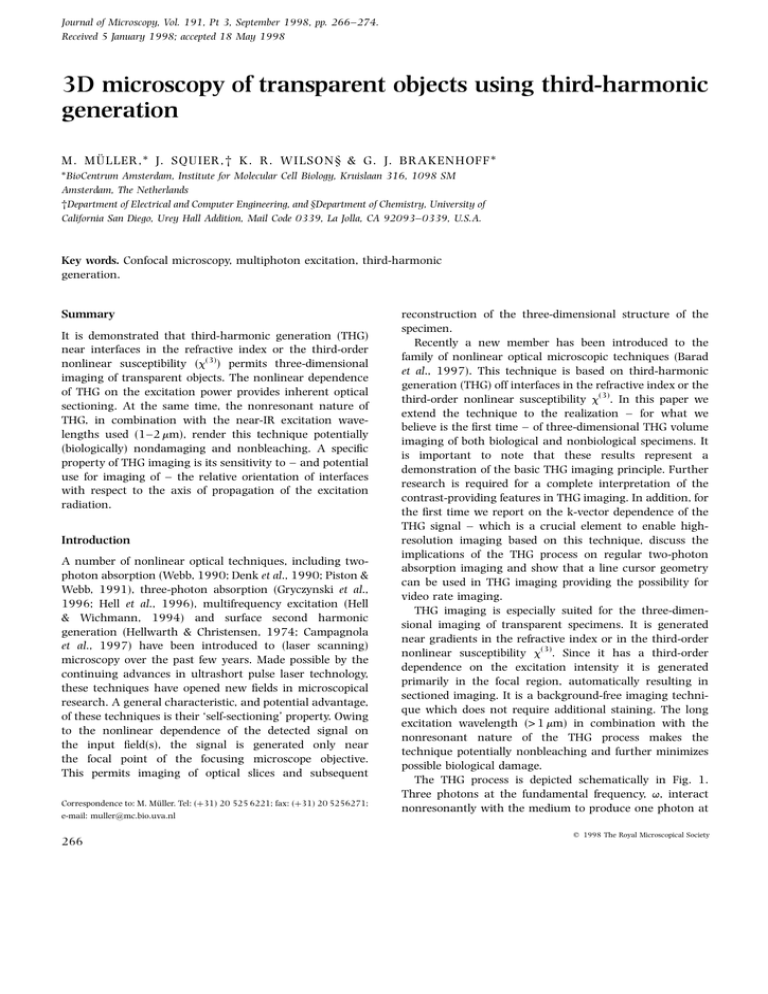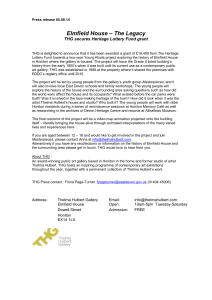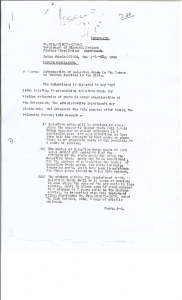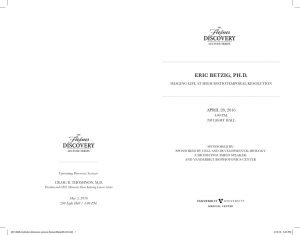3D microscopy of transparent objects using third
advertisement

Journal of Microscopy, Vol. 191, Pt 3, September 1998, pp. 266–274. Received 5 January 1998; accepted 18 May 1998 3D microscopy of transparent objects using third-harmonic generation M. MÜLLER,* J. SQUIER,† K. R. WILSON§ & G. J. BRAKENHOFF* *BioCentrum Amsterdam, Institute for Molecular Cell Biology, Kruislaan 316, 1098 SM Amsterdam, The Netherlands †Department of Electrical and Computer Engineering, and §Department of Chemistry, University of California San Diego, Urey Hall Addition, Mail Code 0339, La Jolla, CA 92093–0339, U.S.A. Key words. Confocal microscopy, multiphoton excitation, third-harmonic generation. Summary It is demonstrated that third-harmonic generation (THG) near interfaces in the refractive index or the third-order nonlinear susceptibility (x(3)) permits three-dimensional imaging of transparent objects. The nonlinear dependence of THG on the excitation power provides inherent optical sectioning. At the same time, the nonresonant nature of THG, in combination with the near-IR excitation wavelengths used (1–2 mm), render this technique potentially (biologically) nondamaging and nonbleaching. A specific property of THG imaging is its sensitivity to – and potential use for imaging of – the relative orientation of interfaces with respect to the axis of propagation of the excitation radiation. Introduction A number of nonlinear optical techniques, including twophoton absorption (Webb, 1990; Denk et al., 1990; Piston & Webb, 1991), three-photon absorption (Gryczynski et al., 1996; Hell et al., 1996), multifrequency excitation (Hell & Wichmann, 1994) and surface second harmonic generation (Hellwarth & Christensen, 1974; Campagnola et al., 1997) have been introduced to (laser scanning) microscopy over the past few years. Made possible by the continuing advances in ultrashort pulse laser technology, these techniques have opened new fields in microscopical research. A general characteristic, and potential advantage, of these techniques is their ‘self-sectioning’ property. Owing to the nonlinear dependence of the detected signal on the input field(s), the signal is generated only near the focal point of the focusing microscope objective. This permits imaging of optical slices and subsequent Correspondence to: M. Müller. Tel: (þ31) 20 525 6221; fax: (þ31) 20 5256271; e-mail: muller@mc.bio.uva.nl 266 reconstruction of the three-dimensional structure of the specimen. Recently a new member has been introduced to the family of nonlinear optical microscopic techniques (Barad et al., 1997). This technique is based on third-harmonic generation (THG) off interfaces in the refractive index or the third-order nonlinear susceptibility x(3). In this paper we extend the technique to the realization – for what we believe is the first time – of three-dimensional THG volume imaging of both biological and nonbiological specimens. It is important to note that these results represent a demonstration of the basic THG imaging principle. Further research is required for a complete interpretation of the contrast-providing features in THG imaging. In addition, for the first time we report on the k-vector dependence of the THG signal – which is a crucial element to enable highresolution imaging based on this technique, discuss the implications of the THG process on regular two-photon absorption imaging and show that a line cursor geometry can be used in THG imaging providing the possibility for video rate imaging. THG imaging is especially suited for the three-dimensional imaging of transparent specimens. It is generated near gradients in the refractive index or in the third-order nonlinear susceptibility x(3). Since it has a third-order dependence on the excitation intensity it is generated primarily in the focal region, automatically resulting in sectioned imaging. It is a background-free imaging technique which does not require additional staining. The long excitation wavelength (> 1 mm) in combination with the nonresonant nature of the THG process makes the technique potentially nonbleaching and further minimizes possible biological damage. The THG process is depicted schematically in Fig. 1. Three photons at the fundamental frequency, q, interact nonresonantly with the medium to produce one photon at q 1998 The Royal Microscopical Society T H I R D -H A R M O N I C G E N E R AT I O N I M AG I N G O F T R A N SPA R EN T O B J E C T S 267 Since the efficiency of THG scales with the third power of the excitation power, it is, for a given input power, inversely proportional to the square of the input pulse duration. Hence, there is a clear advantage in using ultrashort pulses for THG imaging. We have recently shown that pulses as short as 15 fs can be produced at the focus of a highnumerical-aperture (NA) microscope objective when proper dispersion precompensation schemes are used (Müller et al., 1995, 1998). Fig. 1. Schematic energy diagram for THG. The straight line denotes the ground state of the system and dotted lines represent so-called virtual states. In the processes three photons at the fundamental wavelength, q, are converted into one photon at the third-harmonic frequency, 3q. the third-harmonic frequency, 3q. This process has been described in detail by various groups for the case of THG through-focusing in gases (Ward & New, 1969; Largo et al., 1987; Eramo & Matera, 1994) and we summarize only the main features here. In the process, the optical field at the fundamental wavelength (Eq) induces a macroscopic polarization (P3q) of the form P3q ~ xð3Þ E3q ð1Þ which in turn generates a field at the third harmonic frequency (E3q). It follows that the THG power, P3q, has a third-order dependence on the incident power, Pq, P3q ~ ½xð3Þ ÿ2 P3q : ð2Þ Following Barad et al. (1997) and Boyd (1992), the THG power in the case of strong focusing of a Gaussian beam can be expressed as ð3aÞ P3q ~ P3q jJj2 where ∞ ð3Þ x ðzÞ eiDkbz dz : ð3bÞ J¼ 2 ¹ ∞ ð1 þ 2izÞ In Eq. (3b), the integration extends over the volume of the medium, z denotes the axial position, b ¼ kqw02 is the confocal parameter (i.e. the axial width of the focal field distribution), with kq the wave vector at the fundamental wavelength and w0 the beam waist radius and Dk ¼ 3kq ¹ k3q the phase mismatch. Calculation of this integral shows that efficient THG in a uniform medium with a focused laser beam is possible only for Dk > 0. Hence in normally dispersive materials, where Dk # 0, no THG is possible. However, when the medium is not uniform, i.e. when there is an interface either in refractive index or in the third-order nonlinear susceptibility x(3), significant THG can be observed. Note that the above treatment relies solely on a breakage in axial symmetry for bulk third-harmonic generation, rather than on a surface enhancement as proposed by Tsang (1995). q 1998 The Royal Microscopical Society, Journal of Microscopy, 191, 266–274 Experimental The experimental set-up is shown in Fig. 2. The excitation source consists of a 1-kHz optical parametric amplifier (OPA) (Wilson & Yakovlev, 1996), operating at 1·2 mm with a pulse duration of < 50 fs. The pulse energy of 70 mJ per pulse is reduced, using neutral density filters, to < 1 mJ per pulse at the output of the focusing objective. A long-wave pass RG1000 filter blocks any residual white light or 800 nm pump light from the OPA. The single-axis scanning mirror is positioned in a plane conjugate to that of the objective’s entrance pupil. To permit high-speed image acquisition and efficient use of the available OPA power, a 100-mm cylindrical lens is used for line cursor mode excitation. The excitation light is focused onto the specimen with a Nikon PlanApo 10/0·45 microscope objective and the THG emission is collected in the forward direction with an Edmund Scientific 10/0·25 microscope objective, which images it directly onto a Hamamatsu C5985 video CCD camera. Any residual excitation light is blocked by a 400nm interference filter (Andover 400FS20, FWHM 20 6 4 nm) in front of the camera. The effective length of the line cursor in the focal plane is < 530 mm. With a width of the line cursor of < 2 mm, this results in a maximum intensity at the specimen of the order of 1012 W cm –2. To ascertain the proper characteristics of the signal, the Fig. 2. Experimental set-up for THG imaging. OPA: optical parametric amplifier; F1: RG1000 long-wave pass filter; Ms: singleaxis scan mirror; L: 100-mm cylindrical lens; O1: Nikon PlanApo 10/0·45 microscope objective; S: specimen; O2: Edmund Scientific 10/0·25 microscope objective; F2: 400-nm interference band-pass filter; V: video CCD camera. 268 M . M Ü L L E R E T A L . third-order dependence of the THG on the excitation power was checked routinely. A typical result is shown in Fig. 3(a). The straight line represents a linear fit to the data – plotted on a log–log scale – yielding a slope of 3·0 (6 0·07), demonstrating the third-order dependence. Care was taken to operate at power levels below optical breakdown, limiting the range over which the power dependence was measured. The axial resolution of the system is determined by a measurement of the THG intensity as a function of the (axial) position of the glass/air interface of a coverslip, scanned through the focus of the focusing objective (see Fig. 2). Figure 3(b) shows the result for objective O1 (NA ¼ 0·45), giving a full width at half-maximum (FWHM) of the axial THG response of 11·6 (6 0·5) mm. It has been shown (Barad et al. 1997) that the THG axial response is approximately equal to the confocal parameter, b, of the fundamental beam. In other words, the axial response is Fig. 3. (a) Third-order power dependence function of the input power. The slope of (6 0·01). (b) Axial response of the THG interface of a coverslip. The FWHM of (6 0·5) mm. of the THG signal as a the log–log plot is 3·0 signal to the air–glass this response is 11·6 expected to be approximately equal to the FWHM of the axial point spread function (PSF), which for this case (l0 ¼ 1·2 mm, NA ¼ 0·45) is < 12 mm. The generality of this behaviour has been confirmed (data not shown) at high NA, where an axial response of < 1 (6 0·2) mm was observed for l0 ¼ 0·8 mm and NA ¼ 1·25 (oil). As a first example of the imaging potential of the THG technique a series of optical sections has been taken from a fibre (Thorlabs FS-SN-4224) immersed in immersion oil. The fibre (Fig. 4) consists of three layers: the jacket (n1 ¼ 1·540) with an outer diameter of 250 mm, the cladding (n2 ¼ 1·453) with an outer diameter of 125 mm and the core (n3 ¼ 1·458) with a diameter of 5·5 mm. The imaging set-up in these pilot experiments is limited both in signal-to-noise (S/N) – the effective dynamic range is given by a maximum signal count of < 220 against < 1·5 counts additive noise from the detection system – and in axial resolution (NA ¼ 0·45). The result of this is that both the immersion-oil/jacket interface (due to insufficient S/N) and cladding/core (due to insufficient axial resolution) are not resolved in the optical sections shown in Fig. 5. (Note that with an improved S/N the immersion-oil/jacket interface would be resolved readily, as demonstrated by the measured THG signal from an immersion-oil/coverslip interface – see Discussion.) The scanning direction of the line cursor is along the horizontal axis in all images shown. Figure 5 clearly shows the sectioning capability of THG imaging and some imperfections on the cladding’s surface. Another interesting feature is the absence of signal from interfaces orientated parallel to the optical axis. This characteristic can be understood from the requirement of symmetry breakage with respect to the focal plane in bulk THG (see above). Since the generation of the third-harmonic signal depends on the breakage of the axial symmetry with respect Fig. 4. Schematic of the jacket/cladding/core dimensions of the fibre used in the THG imaging experiments. q 1998 The Royal Microscopical Society, Journal of Microscopy, 191, 266–274 T H I R D -H A R M O N I C G E N E R AT I O N I M AG I N G O F T R A N SPA R EN T O B J E C T S 269 Fig. 5. THG imaging optical sections of a fibre immersed in immersion oil. The signal is generated at the jacket/cladding interface. The sections are separated axially by 10 (6 1) mm (the original data set was taken at 5 (6 1)-mm intervals). to the focal plane, it may be expected that the sensitivity of the technique with respect to surfaces orientated parallel to the optical axis increases with increasing NA. Figure 6 shows a three-dimensional reconstruction (based on the simulated fluorescence process method (SFP) (van der Voort et al., 1993). The thickness of the layer shown is determined by the limited axial resolution of the THG imaging set-up. To demonstrate that the THG method is capable of imaging both jacket and core, Fig. 7 shows a number of the optical sections of the top half of the same fibre, this time not immersed in immersion oil. In this case, the refractive q 1998 The Royal Microscopical Society, Journal of Microscopy, 191, 266–274 index change at the air/jacket interface is large enough to overcome the limited S/N, permitting detection of signal generation at both the air/jacket and the jacket/cladding interfaces. Note that no signal is generated in between the interfaces, i.e. in the bulk material. Note also that the signal from the jacket/cladding interface is weaker than that from the air/jacket interface because of the reduced refractive index change. Close inspection of panels 8 and 9 in Fig. 7 shows that the core is visible as a transmission feature, illuminated by third-harmonic radiation generated at the air/jacket interface. 270 M . M Ü L L E R E T A L . Discussion Fig. 6. Three-dimensional reconstruction – based on the SFP method – of the optical sections shown in Fig. 5. The practical applicability of THG imaging and its potential for three-dimensional imaging of biological specimens is demonstrated in Fig. 8. This figure shows several sections of plant leaf cells. The specimen is prepared by cutting a thin slice of the leaf – including the upper epidermis and first layer in the mesophyll – and mounting it with a drop of water. No staining is applied. The bright granular features are probably the chloroplasts on top of the upper epidermis layer of the leaf, the cell walls of which are clearly visible. The three-dimensional structure and the organization of the chloroplasts in ring-shaped structures is evident in the THG images, but can only be guessed in the regular transmission image. It should be re-emphasized at this point that the contrast-generating mechanism in THG imaging is fundamentally different from, for instance, confocal fluorescence or phase contrast microscopy. In THG imaging the contrast results from (local) interfaces in refractive index and/or x(3), whereas confocal fluorescence microscopy measures local fluorescence intensity and phase contrast microscopy is sensitive to accumulated phase differences. Note also that there are several arguments which exclude ‘autofluorescence’ as a potential source for artefacts in the THG-imaging signal. First, the detection is limited to the exact third-harmonic frequency at 400 (6 20) nm. Thus, even for a three-photon absorption process there would have to be a negligible Stokes shift for an autofluorescence signal to occur. Second, no fluorescence signal has been observed in the backscattering direction. Third, the autofluorescence of chloroplasts is primarily at longer wavelength (> 600 nm). Finally, the collection efficiency of the set-up for fluorescence (< 1·5% for the NA ¼ 0·25 objective O2 – see Fig. 2) is extremely small. A number of general observations can be made with respect to THG imaging. First, the third-harmonic radiation is generated predominantly in the forward direction. In fact, we have not observed any THG in the backscattering direction. Second, as may be expected from the IR wavelength of excitation and the nonresonant property of the THG process, there is no apparent bleaching. We have monitored images of the leaf (as shown in Fig. 8) – while the leaf was continuously exposed to the laser radiation – for over an hour without observing any significant change in detected THG intensity. Third, there is an upper limit both in power and in intensity that can be used in THG imaging in particular and nonlinear optical imaging with ultrashort pulses in general. This limit is set by the onset of processes like white light generation, self-focusing and cavitation. In our experiments we observed both white light generation and cavitation on the cladding/jacket interface of the fibre when working above this power limit. A dramatic example of this phenomenon is shown in Fig. 9. The breakdown of the medium is a threshold phenomenon. Care was taken to apply a laser power well below this threshold in all images taken other than in Fig. 9. The potential advantages of the THG imaging technique are obvious. It is a background-free imaging technique which requires no additional staining of the specimen and provides inherent optical sectioning. At the same time it is a nondamaging microscopical technique since it relies on nonresonant excitation at near-IR wavelengths where most specimens are nonabsorbing, but still refractive. This nondamaging characteristic is especially important for applications involving live specimens. The technique is sensitive to changes in both refractive index and x(3). For example, we could easily resolve the immersion-oil/coverslip interface in THG, although the two are refractive index matched. This means that materials which have almost identical refractive index but significant differences in x(3) will produce substantial THG. An additional significant difference with conventional ‘phase contrast’ techniques is that the THG imaging technique is sensitive to local changes in refractive index, rather than in an accumulated phase difference. A specific aspect of the technique is its sensitivity to the orientation of the direction of propagation of the excitation light, relative to the plane of the interfaces. This sensitivity could be exploited, for instance by making – in a high-NA system – multiple images at various orientations of the specimen with respect to the optical axis, or vice versa by using different regions of the high-NA illumination cone. An interesting opportunity presents itself in combining THG imaging with three-photon absorption (3PA) imaging. In this case the former is detected in the forward direction, whereas the latter can be detected in the backscattering q 1998 The Royal Microscopical Society, Journal of Microscopy, 191, 266–274 T H I R D -H A R M O N I C G E N E R AT I O N I M AG I N G O F T R A N SPA R EN T O B J E C T S 271 Fig. 7. THG imaging optical sections of a fibre in air. The THG signal is generated both at the air/jacket interface and at the jacket/cladding interface. The sections are from the top half of the fibre and are separated axially by 10 (6 1) mm (the original data set was taken at 5 (6 1)-mm intervals). direction. Such a set-up would provide the opportunity for relative localization of fluorescence labelling dyes with respect to interfaces in refractive index and/or x(3). Both THG and 3PA provide inherent three-dimensional imaging potential and can be done simultaneously. Since the sectioning in both techniques is determined by the excitation process, co-localizing the THG and 3PA images is straightforward. We have already observed substantial 3PA in Rhodamine 6G at 1·2 mm. An important observation is the general presence of THG q 1998 The Royal Microscopical Society, Journal of Microscopy, 191, 266–274 when using ultrashort pulses. A significant THG signal is always produced near the interface of the coverslip. This is especially relevant for two-photon absorption (TPA) imaging, where the excitation energies generally used (0·01– 1 nJ per pulse) are more than sufficient to produce substantial amounts of THG. Similarly, THG will be produced at existing interfaces while imaging the specimen. Since TPA imaging is commonly done near 800 nm, this implies that significant amounts of 265-nm radiation may routinely be generated. Although much of this UV light will 272 M . M Ü L L E R E T A L . Fig. 8. Several THG imaging optical sections of plant leaf cells. The leaf is used as found and prepared by cutting a thin slice – including the upper epidermis and part of the mesophyll – and mounting it with a drop of water. The upper epidermis is at the bottom of the specimen. The sections are a selection of a complete stack, taken at 5 (6 1) mm axial spacing, at axial positions as indicated in the figure. Panel 5 shows the regular widefield transmission image. be absorbed by water, the radiation damage induced in TPA imaging through THG requires careful examination. The occurrence of THG in TPA imaging will generally pass unnoticed since the radiation produced is absorbed by either the specimen or the glass and thus remains confined to the specimen. There are multiple ways to diminish this possible harmful side-effect of THG in TPA imaging. For instance, since the integrated TPA fluorescence signal scales linearly with the pulse duration (for constant pulse energy), whereas the integrated THG signal has a quadratic dependence, increasing the pulse width by a factor of 10 would require a 10 times longer integration time in TPA imaging, while reducing the THG by an order of magnitude. Alternatively one could change to a longer wavelength and use a three-photon absorption process instead, hence shifting the THG to longer wavelength as well, where they are potentially less damaging. Given sufficient excitation power levels, the THG process generally provides a signal, which is readily recorded on a standard video CCD camera. Combined with the fact that the repetition rate of the excitation laser source can be maximized owing to the instantaneous nonresonant nature of THG, this points to real-time THG imaging potential. In fact, we have already observed THG imaging of the coverslip surface at semi video rates, using only a 1-kHz OPA system. Several new laser systems – especially fibre lasers – are now q 1998 The Royal Microscopical Society, Journal of Microscopy, 191, 266–274 T H I R D -H A R M O N I C G E N E R AT I O N I M AG I N G O F T R A N SPA R EN T O B J E C T S 273 Fig. 9. Several THG imaging exposures – taken 1 min apart – of a single optical section of the fibre of Fig. 5. The excitation power level is above damage threshold, resulting in cavitation at the jacket/cladding interface. becoming available commercially (Sucha, 1998); these combine sufficient power, pulse duration, operating wavelength and repetition rate to make them suitable for THG imaging at an affordable price level. In summary, we have presented three-dimensional THG imaging near x(3) and/or refractive index interfaces in both biological specimens and nonbiological samples, using a line cursor mode laser scanning transmission microscope. The technique permits potentially nondamaging and nonbleaching optical sectioning of transparent specimens. The general features of the technique suggest that it may find q 1998 The Royal Microscopical Society, Journal of Microscopy, 191, 266–274 application in fields ranging from biology to the materials sciences. We are currently investigating the fundamental properties of the technique and the extension to high-NA imaging. Acknowledgments This research was financially supported in part by the Stichting voor Fundamenteel Onderzoek der Materie, Utrecht, The Netherlands, under grant no. 94RG02. This work was performed at the University of California at San Diego. 274 M . M Ü L L E R E T A L . References Barad, Y., Eisenberg, H., Horowitz, M. & Silberberg, Y. (1997) Nonlinear scanning laser microscopy by third-harmonic generation. Appl. Phys. Lett. 70, 922–924. Boyd, R.W. (1992) Nonlinear Optics. Academic Press, Boston. Campagnola, P.J., Young, D.W., Cowan, A.E., Roychoudhuri, C. & Loew, L.M. (1997) Applications in nonlinear optical microscopy. Cell Vision, 4, 191–192. Denk, W., Strickler, J.H. & Webb, W.W. (1990) Two-photon laser scanning fluorescence microscopy. Science, 248, 73–76. Eramo, R. & Matera, M. (1994) Third-harmonic generation in positively dispersive gases with a novel cell. Appl. Opt. 33, 1691– 1696. Gryczynski, I., Malak, H. & Lakowicz, J.R. (1996) Multiphoton excitation of the DNA stains DAPI and Hoechst. Bioimaging, 4, 138–148. Hell, S.W., Bahlmann, K., Schrader, M., Soini, A., Malak, H., Gryczynski, I. & Lakowicz, J.R. (1996) Three-photon excitation in fluorescence microscopy. J. Biomed. Opt. 1, 71–74. Hell, S.W. & Wichmann, J. (1994) Breaking the diffraction resolution limit by stimulated emission: stimulated-emissiondepletion fluorescence microscopy. Opt. Lett. 19, 780–782. Hellwarth, R. & Christensen, P. (1974) Nonlinear optical microscopic examination of structure in polycrystalline ZnSe. Opt. Commun. 12, 318–322. Largo, A., Hilber, G. & Wallenstein, R. (1987) Optical frequency conversion in gaseous media. Phys. Rev. A, 36, 3827–3836. Müller, M., Squier, J. & Brakenhoff, G.J. (1995) Measurement of femtosecond pulses in the focal point of a high-numericalaperture lens by two-photon absorption. Opt. Lett. 20, 1038– 1040. Müller, M., Squier, J., Wolleschensky, R., Simon, U. & Brakenhoff, G.J. (1998) Dispersion pre-compensation of 15 femtosecond optical pulses for high-numerical-aperture objectives. J. Microsc. 191, 141–158. Piston, D.W. & Webb, W.W. (1991) Three dimensional imaging of intracellular calcium activity using two-photon excitation of fluorescent indicator dye Indo-1. Biophys. J. 59, 156. Sucha, G. (1998) Doped optical fibers promise compact femtosecond sources. Laser Focus World, April, 121. Tsang, T.Y.F. (1995) Optical third-harmonic generation at interfaces. Phys. Rev. A, 52, 4116–4125. van der Voort, H.T.M., Messerli, J.M., Noordmans, H.J. & Smeulders, A.W.M. (1993) Volume visualization for interactive microscopic analysis. Bioimaging, 1, 20–29. Ward, J.F. & New, G.H.C. (1969) Optical third harmonic generation in gases by a focused laser beam. Phys. Rev. 185, 57–72. Webb, W.W. (1990) Two photon excitation in laser scanning fluorescence microscopy. Transactions of the Royal Microscopical Society (ed. by H. Y. Elder), pp. 445–450. Institute of Physics Publishing, Bristol. Wilson, K.R. & Yakovlev, V.V. (1996) Ultrafast rainbow: tunable ultrashort pulses from a solid-state kilohertz system. J. Opt. Soc. Am. B, 14, 444–448. q 1998 The Royal Microscopical Society, Journal of Microscopy, 191, 266–274




